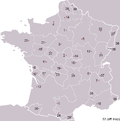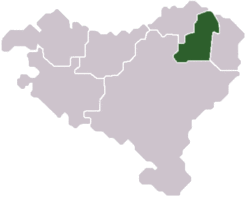- Lower Navarre
-
Lower Navarre
Nafarroa Beherea
Flag
Coat of armsLocation of Lower Navarre within the Northern Basque Country and the greater Basque Country. Country  France
FranceLargest settlements Area – Total 1.325 km2 (13,137 sq mi) Population (1999 estimate) – Total 28,000 Time zone CET (UTC+1) – Summer (DST) CEST (UTC+2) Lower Navarre (Basque: Nafarroa Beherea or Baxenabarre, French: Basse-Navarre, Spanish: Baja Navarra) is a part of the present day Pyrénées Atlantiques département of France. Along with Navarre of Spain, it was once ruled by the Kings of Navarre. Lower Navarre was historically one of the kingdoms of Navarre. Its capital were Saint-Jean-Pied-de-Port and Saint-Palais. In the extreme north there was the little sovereign principality of Bidache.
Its extent is of 1,284 km2, and has a decreasing population of 44,450 (in 1901), 25,356 (in 1990).
Although this denomination is not completely correct from the historical point of view, it is also known as Merindad de Ultrapuertos ("the regions beyond the mountain passes") by the southerners, and Deça-ports ("this side of the mountain passes") by the gascon-speakers.
Geography
Lower Navarre is a collection of valleys in the foothills of the Pyrenees. The Aldudes valley, around the town of Saint-Étienne-de-Baïgorry in the south of Lower Navarre, preserves many old traditions, with houses of pink sandstone and contests of Force Basque, the games of strength. The Irouléguy wines are produced in the area around the town of Irouléguy.
The river Nive rises in Lower Navarre and flows through the province and on to Bayonne, where it meets the Adour. Beyond Saint-Jean-Pied-de-Port itself, the Nive enters the Ossès valley, with many beautiful old houses with carved lintels in the villages of Ossès, Irissarry and Bidarray. A reserve for the pottok, the wild Basque Pyrennean pony, in the valley conserves this rare breed.
North of Saint-Jean-Pied-de-Port is the Mixe region around the town of Saint-Palais, a former Navarrese capital. Although close to Béarn, Basque influence and traditions are strong. Lower Navarrese is a dialect of the Basque language spoken in the region. Just south of Saint-Palais, the three principal routes to Santiago de Compostela on the Way of St James met at the hamlet of Ostabat, bringing much wealth and trade to the area in medieval times.
The Way of St James headed south from Saint-Jean-Pied-de-Port towards the mountain pass above Roncesvalles. Pilgrims travelled across the Cize region of Lower Navarre on their way to Navarre across the mountains. In these rolling hills, ewes' milk cheese, pur brebis, is commonly made, including Ossau-Iraty cheese. Villages like Estérençuby and Lecumberry are popular for agro-tourism and the Iraty beech forest on the Spanish border is known for its views and history. Dolmens and other neolithic monuments dot the landscape, including the Tour d'Urkulu high in the mountains at 1,149m—a 2,000-year-old circular platform of huge stone blocks. Lower Navarre is well delimited by mountain ranges on the west (with Mount Iparla as its highest and most iconic landmark), south (Roncevaux, Mount Urkulu and Pyrenees altogether) and the east (bounded by the western mountains of Soule).
History
The lands of the Lower Navarre were part of the Duchy of Vasconia turned into Gascony by the end of the first millennium. At the time of Sancho III of Navarre, called the Great (died in 1035), Sancho VI William of Gascony pledged allegiance to the Navarrese king. Navarre became suzerain to Gascony, with whom it had always held close ties. Moreover, the valleys of Baigorri, Ossès, Arberoa, Cize and Arberoa were attached to the former, so establishing the first nucleus of the Navarrese grip on the lands north of the Pyrenees. While these valleys were taken over again by Gascony for a period, the Ultrapuertos County (called Merindad in Navarre) was regained for Navarre in 1234, coming to be governed by the sheriff of Saint-Jean-Pied-de-Port. However, the definite boundaries were not established until the 1244-1245 war between Labourdins and Navarrese came to an end.
In 1512 the Duke of Alba under orders from king Ferdinand II of Aragon led an army that invaded Navarre, seizing Saint-Jean-Pied-de-Port. In 1516 king John III of Navarre re-captured the town, while Spain's Charles I's 10,000 strong army held it again. However, given the difficulties posed by the defence of this outpost across the Pyrenees, he gave up the position in 1521, allowing king Henry II of Navarre to take over the whole county. Eventually, the legitimate Navarrese king, stripped de facto of the rest of Navarre now under Spanish rule, restored Navarrese official institutions and bodies in the Lower Navarre, e.g. the Parliament in 1523, the Chancery in 1524, the Royal Mint a bit later in Saint-Palais (Donapaleu in Basque), etc. On these grounds, the title of King of Navarre continued to be held by the lineage of the Albrets and the Bourbons up to the French Revolution, while the kingdom itself merged with France in 1620. However, the seat of the Navarrese Royalty shifted to Pau, capital city of Béarn.
Traditional provinces of the Basque Country Southern Basque Country : Basque Autonomous Community (Gipuzkoa · Álava · Biscay) · Navarre
Northern Basque Country : Labourd · Lower Navarre · Soule

 Historical Provinces of France
Historical Provinces of FranceProvinces Alsace • Angoumois • Anjou • Artois • Aunis • Auvergne • Basse-Navarre • Béarn • Beaujolais • Berry • Bourbonnais • Brittany • Burgundy • Champagne • Corsica • Dauphiné • Flanders and Hainaut • Foix • Forez • Franche-Comté • Gascony • Guyenne • Île-de-France • Languedoc • Limousin • Lorraine • Lyonnais • Maine • Marche • Montbéliard • Mulhouse • Nice • Nivernais • Normandy • Orléanais • Perche • Picardy • Poitou • Provence • Roussillon • Saintonge • Savoy • Touraine • Trois-Évêchés • Venaissin Categories:
Categories:- Former provinces of France
- Basque
- Nafarroa Beherea
Wikimedia Foundation. 2010.

